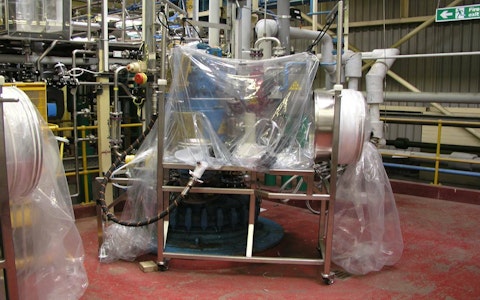The increasing use of high potent active pharmaceutical ingredients (HPAPIs) in cancer treatment drugs is proving highly effective in saving lives, but they can pose a severe risk to process technicians and process engineers during production – and if mistakes are made the results could be fatal.
For example, Dolastatin 10 and Ansamitocin
are amazing drugs. One is harvested from a marine mollusc and the other from an African shrub – and while they have two very different backstories, what they have in common is that they are both cytotoxic. Used in microscopic doses, this quality enables a targeted approach to modern treatments that are transforming oncology.
They form part of the HPAPI section of the pharmaceutical industry, which now accounts for 25% of all drugs produced. It’s a sector that is projected to be worth $40 billion by 2027.
Potential dangers
The challenge with HPAPIs, however, lies in their efficacy. Intended to be toxic to cells, they have a typical occupational exposure limit that is under 10 micrograms per cubic metre, and this requires tight manufacturing controls – as their high potency means the consequences of even a small mistake can lead to a range of life-threatening side effects and even death to the operator.
Mistakes would also leave drug manufacturers exposed financially if something goes wrong as the penalties can be huge. The potential implication of such a mistake was illustrated by the record $500 million a global leading drug manufacturer had to pay in 2013 when safety violations were found to have occurred while manufacturing generic drugs at its plant.
With the pharmaceutical industry relying on a network of specialist contract manufacturers, it’s conceivable that such an incident could force these companies out of business if a violation or contaminated batch was traced back to their sites. HPAPI safety is therefore crucial to maintaining operations.
Managing toxicity
With HPAPIs, manufacturers need to be particularly wary of the dangers, as their physical nature heightens the risks involved during production. Some are dense compounds, but others are highly micronised and exist almost as a gas. This makes the risk of cross-contamination significantly worse since standard cleaning procedures, used after the manufacturing of conventional drugs, may not be effective, and visible checks would not be enough to validate the process.
This can add major costs to manufacturing as facilities require more intensive cleaning before any further work can take place on site. It also means companies are paying for a facility to stand idle while these processes are carried out.
While the competitive nature of the market means that businesses will want to minimise the cost of production, they need to be careful how they do this when it comes to HPAPI safety. Fundamentally, ensuring that engineering controls are in place that properly contain manufacturing lines – and they are not placing unrealistic faith in personal protective equipment (PPE).
Where operators are dealing with microscopic amounts of toxic, gaseous compounds, PPE is only the last line of defence. In some cases, failure to provide proper containment systems has led to deaths of workers – despite the fact they were wearing PPE.
Containment solutions
In contrast to PPE, containment solutions safely separate workers from the production process and remove the risk of exposure. Traditionally this would involve rigid isolators – but, while these units are still popular, they can be costly and they still require intense cleaning and validation after every use.
This is a key reason why many manufacturers are increasingly turning their attention to flexible alternatives, such as polymer glove bag isolators, that are more cost effective. These flexible solutions use specialist protective films made of polyurethane, polyethylene and PVC, to prevent any harmful ingredients reaching the operators. This film typically fits on an ergonomically sound rigid structural stainless steel frame, with other necessary equipment installed around it.
One of the big benefits of this is that when production is complete, the flexible film isolator glove bag can be removed and safely disposed of until a new containment enclosure is installed. The cleaning process is greatly reduced and often not required, meaning downtime validation is minimised. All that needs to be replaced is the protective film itself, and this keeps costs to an absolute minimum.
Increasing speed to market
Flexible solutions also provide huge advantages in that they can be quickly installed in different spaces and contexts. Broadly speaking, any pharmaceutical manufacturing environment where a support structure can be installed is suitable for these containment systems.
Many operators are surprised these flexible solutions can deliver the necessary protection, but this type of high containment has been proven to achieve less than 1 µg/m3 (OEB 5). This technology can also support products with OELs in the nanogram range.
This approach, along with the reduced cleaning validation, is helping manufacturers overcome a broad range of problems that would otherwise be preventing the pharmaceutical industry from manufacturing life-saving HPAPI compounds and getting them to patients faster.
In an industry where getting to market quickly can make a big difference to a company’s prospects, this is providing manufacturers with an alternative solution that helps them to be more competitive – without risking the health or safety of their workers, and effecting the quality of their products, in the process.
This article originally appeared in European Pharmaceutical Manufacturer in October 2022 and can be viewed here: https://pharmaceuticalmanufact...



